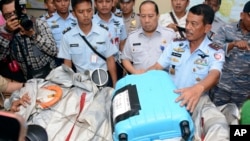Indonesian officials have recovered at least 40 bodies from the sea near the wreckage of an AirAsia passenger jet that crashed during a storm Sunday.
Local television Tuesday showed rescue helicopters pulling bodies from the Java Sea, about 160 kilometers off the coast of Borneo Island.
Families of some of the 162 people on board AirAsia Flight 8501 burst into tears and hugged one another after seeing the images of the floating bodies, which were not wearing life jackets, and wreckage.
No survivors have been found
By nightfall, rescuers had recovered only a quarter of those on board the jet. None of the passengers or crew have been found alive.
The bodies were located shortly after the discovery of wreckage, including what appeared to be an orange life jacket, luggage, and a red and white emergency door.
The plane is yet to be found, but Indonesian officials have spotted a "shadow" under the surface of the water that is believed to be the main body of the Airbus A320-200.
In a statement late Tuesday, AirAsia confirmed the wreckage was the missing plane, which disappeared Sunday, about halfway through what was supposed to be a brief, two-hour flight from the Indonesian city of Surabaya to Singapore.
Tony Fernandes, the CEO and founder of AirAsia, said he is "absolutely devastated" at the news. Earlier on Twitter, Fernandes said his "heart is filled with sadness for all the families involved," and that "words cannot express how sorry I am."
At least 30 ships, 15 aircraft and seven helicopters from several countries have been looking for the plane between Borneo and Sumatra islands. The shallowness of the sea, between 40 to 50 meters deep, is expected to aid efforts to recover the aircraft and vital communications data including the voice recorder.
Fransiskus Bambang Soelistyo, head of the Search and Rescue Agency, told reporters, “The challenge is waves up to three meters high” at the site where they are retrieving bodies and debris. He added the search operation would go on all night. He declined to answer questions on whether any survivors had been found.
The search effort will be bolstered Tuesday with the arrival of a U.S. Navy warship. The USS Sampson, which was already on deployment in the area, is equipped with sonar devices that can scan underwater.
The passengers include 149 Indonesians, three South Koreans, and one each from Britain, Malaysia, and Singapore. The crew included six Indonesians and a French co-pilot.
No distress signal
Initial investigation of the cause of the crash blames severe weather for the latest tragedy.
The twin-engine plane gave no distress signals before disappearing, though pilots had asked permission to fly at a higher altitude to avoid a storm cloud.
Indonesian officials say that permission was not granted because other planeswere in the area. The jet was instead approved to fly around the storm.
Hugh Ritchie, chief executive of Sydney-based Aviation Consultants International, told VOA satellite images highlighted the storm’s ferocity.
“This was pretty ferocious. You are going to have very strong up-draft and very strong down-draft - quite sufficient to cause the aircraft to disappear," Ritchie said.
"And while it may not destroy the aircraft, the stress could cause the aircraft to break up in the air. I would assume that icing or a combination of icing and severe turbulence would have caused this accident," he added.
Low-cost airlines
The plane was operated by the Indonesian affiliate of AirAsia, a Malaysian-based, low-cost airline that previously had a spotless safety record. Altogether the group has over 170 aircraft amid the fast-growing aviation sector in Asia where there are 1,600 aircraft operating in the region.
The AirAsia group has affiliates in Thailand, the Philippines and India.
The airline's troubles continued Tuesday on a smaller scale when a plane from subsidiary AirAsia Zest skidded off a runway in the Philippine city of Kalibo with 159 people aboard. No injuries were reported.
The accident is the third for a South East Asian carrier this year.
In March, Malaysia Airlines Flight 370 disappeared while en route from Kuala Lumpur to Beijing. The plane, which was carrying 239 people, is believed to have crashed into the Indian Ocean off the western coast of Australia, though no trace of it has been found.
Two months later, in July, Malaysia Airlines Flight 17 crashed in eastern Ukraine, killing all 298 people on board. Western officials believe that plane was shot down by Moscow-backed Ukrainian rebels.
On Wednesday families of the victims are to be flown from Surabaya to Belitung Island, located on the east coast of Sumatra, to formally identify victims from AirAsia tragedy.
Ron Corben contributed to this report from Bangkok. Some material for this report came from Reuters.









